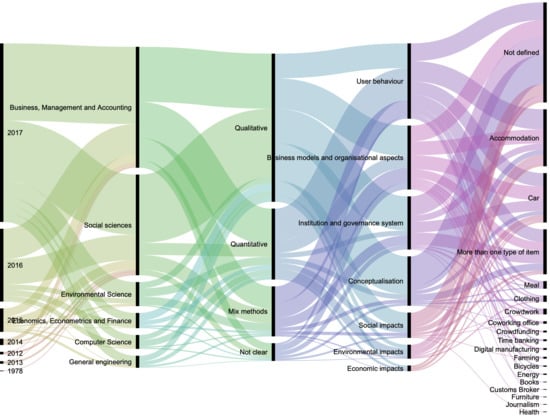Characterizing the Sharing Economy State of the Research: A Systematic Map
Abstract
1. Introduction
2. Theoretical Background
3. Materials and Methods
3.1. Systematic Mapping
3.2. Objective of the Map
3.2.1. Objective Formulation
- O1.
- To characterize and map research associated with the sharing economy phenomenon, describing the developments, themes and recurrent features of the research;
- O2.
- Provide a map that is searchable by topic;
- O3.
- Inform future research synthesis and evaluation methods such as systematic review;
- O4.
- Identify knowledge gaps in order to inform future primary research.
3.2.2. Research Questions
- RQ1.
- In which knowledge areas, by which journals and when research on sharing economy has been published?
- RQ2.
- Which sharing sectors and items have been studied?
- RQ3.
- What types of transactions (e.g., C2C, B2C, B2B, B2C) have been said to comprise the sharing phenomenon?
- RQ4.
- What research methods and sources of data have been used?
- RQ5.
- What topic areas have been focused?
3.3. Search Strategy and Searches
3.3.1. Databases
3.3.2. Search Terms
- Collaborative education;
- Collaborative production;
- Sharing economy, encompassing collaborative consumption, and collaborative economy.
3.3.3. Saving Results
3.4. Screening and Coding of Titles and Abstracts
3.4.1. Selection Criteria
3.4.2. Development of Coding Categories
3.4.3. Coding
4. Results
4.1. Evolution of Publications on the Research Topic
4.2. Knowledge Areas
4.3. Business Sectors
4.4. Actors Involved and Types of Resource Exchanges
4.5. Research Approach and Methods
4.6. Research Clusters and Recurring Themes
5. Discussion
5.1. Emerging Patterns from the Research Trajectory
5.2. Research Needs from an Environmental Sustainability Perspective
- A behavioral framework for analyzing sharing behaviors and related spending intentions;
- Understanding of the root causes and quantifications of full environmental behavioral effects addressing the fundamental gap whether, to what extent, and under which conditions rebound effects undermine the environmental gains of the sharing economy; and
- Systemic understanding of rebound effects that allows for exploring inconsistencies in values, motives, and actions, i.e., why and how consumers engaged in sharing platforms spend the freed and saved money (involving, thus, dissimilar rebound effects and subsequently, different net environmental impacts), in regards to platform orientation and governance.
6. Conclusions
Supplementary Materials
Author Contributions
Funding
Acknowledgments
Conflicts of Interest
Appendix A
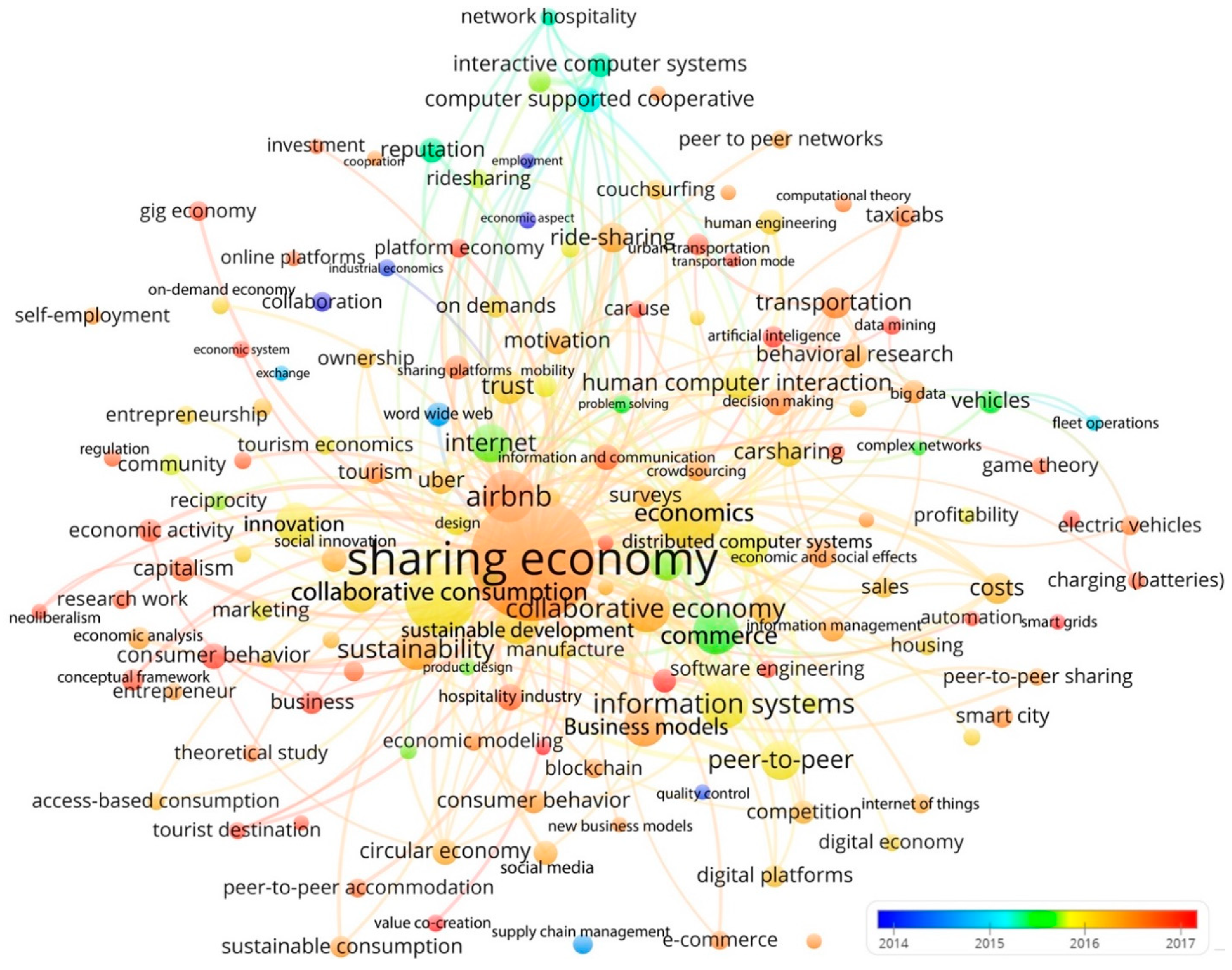
| Publication Type | Quantity |
|---|---|
| Journal article | 618 |
| Books | 53 |
| Book chapters | 19 |
| Conference paper | 252 |
Appendix B
| Cities | Authors | Publication Title | Year | Source Title |
|---|---|---|---|---|
| 2011 | R Botsman, R Rogers | What’s mine is yours: how collaborative consumption is changing the way we live | 2011 | Book |
| 1068 | R Belk | You are what you can access: Sharing and collaborative consumption online | 2014 | Journal of Business Research |
| 850 | J Hamari, M Sjöklint, A Ukkonen | The sharing economy: Why people participate in collaborative consumption | 2016 | Journal of the Association for Information Science and Technology |
| 592 | G Zervas, D Proserpio, JW Byers | The rise of the sharing economy: Estimating the impact of Airbnb on the hotel industry | 2017 | Journal of Marketing Research |
| 407 | J Schor | Debating the sharing economy. | 2016 | Journal of Self-Governance and Management Economics |
| 330 | A Sundararajan | The sharing economy: The end of employment and the rise of crowd-based capitalism | 2016 | Book |
| 318 | M Felson, JL Spaeth | Community structure and collaborative consumption: A routine activity approach | 1978 | American Behavioral Scientist |
| 317 | B Cohen, J Kietzmann | Ride on! Mobility business models for the sharing economy | 2014 | Organization and Environment |
| 292 | M Möhlmann | Collaborative consumption: determinants of satisfaction and the likelihood of using a sharing economy option again | 2015 | Journal of Consumer Behaviour |
| 260 | CJ Martin | The sharing economy: A pathway to sustainability or a nightmarish form of neoliberal capitalism? | 2016 | Ecological Economics |
| Publication Year | Special Issue Title | Journal Title |
|---|---|---|
| 2016 | Regulating the sharing economy | Internet Policy Review |
| 2016 | The risks and opportunities of the sharing economy | European Journal of Risk Regulation |
| 2016 | Mobility and the sharing economy | Transport Policy |
| 2016 | The City as a Lab: open innovation meets the collaborative economy | California Management Review |
| 2017 | Promises and paradoxes of the sharing economy: An organizing framework | Technological Forecasting and Social Change |
| 2017 | Sustainability perspectives on the sharing economy | Environmental Innovation and Societal Transitions |
| 2017 | The Sharing Economy: Opportunities and Challenges for Marketing Channels and Supply Chains | Journal of Marketing Channels |
| 2017 | Shared responsibility and blurring boundaries: Strategic implications of the sharing economy | MIS Quarterly Executive |
| 2017 | Platforms and Ecosystems | Technology Innovation Management Review |
| 2017 | The Silicon Valley Ethos: Tech Industry Products, Discourses, and Practices | Television and New Media |
References
- Laurenti, R.; Sinha, R.; Singh, J.; Frostell, B. Towards Addressing Unintended Environmental Consequences: A Planning Framework. Sustain. Dev. 2016, 24, 1–17. [Google Scholar] [CrossRef]
- Prior, T.; Giurco, D.; Mudd, G.; Mason, L.; Behrisch, J. Resource depletion, peak minerals and the implications for sustainable resource management. Glob. Environ. Chang. 2012, 22, 577–587. [Google Scholar] [CrossRef]
- Frenken, K.; Schor, J. Putting the sharing economy into perspective. Environ. Innov. Soc. Transitions 2017, 23, 3–10. [Google Scholar] [CrossRef]
- Botsman, R.; Rogers, R. What’s Mine Is Yours: How Collaborative Consumption is Changing the Way We Live; HarperCollins Publishers: New York, NY, USA, 2011; ISBN 9780061963551. [Google Scholar]
- Belk, R. Sharing versus pseudo-sharing in web 2.0. Anthropologist 2014, 18, 7–23. [Google Scholar] [CrossRef]
- Richardson, L. Performing the sharing economy. Geoforum 2015, 67, 121–129. [Google Scholar] [CrossRef]
- Puschmann, T.; Alt, R. Sharing economy. Bus. Inf. Syst. Eng. 2016, 58, 93–99. [Google Scholar] [CrossRef]
- Cherry, C.E.; Pidgeon, N.F. Is sharing the solution? Exploring public acceptability of the sharing economy. J. Clean. Prod. 2018, 195, 939–948. [Google Scholar] [CrossRef]
- Bucher, E.; Fieseler, C.; Lutz, C. What’s mine is yours (for a nominal fee)—Exploring the spectrum of utilitarian to altruistic motives for Internet-mediated sharing. Comput. Hum. Behav. 2016, 62, 316–326. [Google Scholar] [CrossRef]
- Dreyer, B.; Lüdeke-Freund, F.; Hamann, R.; Faccer, K. Upsides and downsides of the sharing economy: Collaborative consumption business models’ stakeholder value impacts and their relationship to context. Technol. Forecast. Soc. Chang. 2017, 125, 87–104. [Google Scholar] [CrossRef]
- Godelnik, R. Millennials and the sharing economy: Lessons from a ‘buy nothing new, share everything month’ project. Environ. Innov. Soc. Transit. 2017, 23, 40–52. [Google Scholar] [CrossRef]
- James, K.L.; Randall, N.P.; Haddaway, N.R. A methodology for systematic mapping in environmental sciences. Environ. Evid. 2016, 5, 7. [Google Scholar] [CrossRef]
- Price, J.A. Sharing: The Integration of Intimate Economies. Anthropologica 1975, 17, 3–27. [Google Scholar] [CrossRef]
- Cotrim, J.M.O.; Nunes, F. Sharing Economy: The Establishment of Organizational Identity Overtime, Considering Identify Claims and Legitimacy Granting. Eur. J. Econ. Bus. Stud. 2017. [Google Scholar] [CrossRef][Green Version]
- Mauss, M. Essai Sur Le Don Forme Et Raison De L’échange Dans Les Sociétés Archaïquès. “The gift: The form and reason for exchange in archaic societies”. L’Année Sociol. 1923, 1, 30–186. [Google Scholar]
- Hyde, L. The Gift: Imagination and the Erotic Life of Property; Vintage Books: New York, NY, USA, 1983; ISBN 0-394-71519-5. [Google Scholar]
- Hyde, L. Common As Air: Revolution, Art, and Ownership; Farrar, Straus and Giroux: New York, NY, USA, 2010; ISBN 0374532796. [Google Scholar]
- Lessig, L. Remix: Making Art and Commerce Thrive in the Hybrid Economy; Bloomsbury Academic: London, UK, 2008. [Google Scholar]
- Belk, R. Sharing. J. Consum. Res. 2010, 36, 715–734. [Google Scholar] [CrossRef]
- Curtis, S.K.; Lehner, M. Defining the sharing economy for sustainability. Sustainability 2019, 11, 567. [Google Scholar] [CrossRef]
- Petersen, K.; Vakkalanka, S.; Kuzniarz, L. Guidelines for conducting systematic mapping studies in software engineering: An update. Inf. Softw. Technol. 2015, 64, 1–18. [Google Scholar] [CrossRef]
- Petersen, K.; Feldt, R.; Mujtaba, S.M. Mattsson Systematic mapping studies in software engineering. In EASE’08 Proceedings of the 12th international conference on Evaluation and Assessment in Software Engineering, Bari, Italy, 26–27 June 2008; BCS Learning & Development Ltd.: Swindon, UK, 2008; pp. 68–77. [Google Scholar]
- Clapton, J.; Rutter, D.; Sharif, N. SCIE Systematic Mapping Guidance; SCIE: London, UK, 2009. [Google Scholar]
- Randall, N.P.; James, K.L. The effectiveness of integrated farm management, organic farming and agri-environment schemes for conserving biodiversity in temperate Europe—A systematic map. Environ. Evid. 2012, 1, 4. [Google Scholar] [CrossRef]
- Grant, M.J.; Booth, A. A typology of reviews: An analysis of 14 review types and associated methodologies. Heal. Inf. Libr. J. 2009, 26, 91–108. [Google Scholar] [CrossRef]
- Van Eck, N.J.; Waltman, L. Software survey: VOSviewer, a computer program for bibliometric mapping. Scientometrics 2010, 84, 523–538. [Google Scholar] [CrossRef]
- Hamari, J.; Sjöklint, M.; Ukkonen, A. The sharing economy: Why people participate in collaborative consumption. J. Assoc. Inf. Sci. Technol. 2016, 67, 2047–2059. [Google Scholar] [CrossRef]
- Plewnia, F.; Guenther, E. Mapping the sharing economy for sustainability research. Manag. Decis. 2018, 56, 570–583. [Google Scholar] [CrossRef]
- Trenz, M.; Frey, A.; Veit, D. Disentangling the facets of sharing: A categorization of what we know and don’t know about the Sharing Economy. Internet Res. 2018, 28, 888–925. [Google Scholar] [CrossRef]
- Charmaz, K. Constructing Grouded Theory; SAGE Publications Ltd.: London, UK, 2014; ISBN 9788578110796. [Google Scholar]
- Strauss, A.; Corbin, J. Grounded Theory Methodology: An Overview. In Handbook of Qualitative Research; Denzin, N.K., Lincoln, Y.S., Eds.; Sage Publications, Inc.: Thousand Oaks, CA, USA, 1994; pp. 273–285. ISBN 0803946791. [Google Scholar]
- Felson, M.; Spaeth, J.L. Community Structure and Collaborative Consumption: A Routine Activity Approach. Am. Behav. Sci. 1978, 21, 614–624. [Google Scholar] [CrossRef]
- Zamani, B.; Sandin, G.; Peters, G.M. Life cycle assessment of clothing libraries: Can collaborative consumption reduce the environmental impact of fast fashion? J. Clean. Prod. 2017, 162, 1368–1375. [Google Scholar] [CrossRef]
- Möhlmann, M. Collaborative consumption: Determinants of satisfaction and the likelihood of using a sharing economy option again. J. Consum. Behav. 2015, 14, 193–207. [Google Scholar] [CrossRef]
- Cohen, B.; Kietzmann, J. Ride On! Mobility Business Models for the Sharing Economy. Organ. Environ. 2014, 27, 279–296. [Google Scholar] [CrossRef]
- Täuscher, K.; Laudien, S.M. Understanding platform business models: A mixed methods study of marketplaces. Eur. Manag. J. 2018, 36, 319–329. [Google Scholar] [CrossRef]
- Richter, C.; Kraus, S.; Brem, A.; Durst, S.; Giselbrecht, C. Digital entrepreneurship: Innovative business models for the sharing economy. Creat. Innov. Manag. 2017, 26, 300–310. [Google Scholar] [CrossRef]
- Pfeffer-Gillett, A. When “disruption” collides with accountability: Holding ridesharing companies liable for acts of their drivers. Calif. Law Rev. 2016, 104, 233–268. [Google Scholar]
- McKee, D. Neoliberalism and the legality of peer platform markets. Environ. Innov. Soc. Transit. 2017, 23, 105–113. [Google Scholar] [CrossRef]
- Minter, K. Negotiating labour standards in the gig economy: Airtasker and Unions New South Wales. Econ. Labour Relat. Rev. 2017, 28, 438–454. [Google Scholar] [CrossRef]
- Gruszka, K. Framing the collaborative economy —Voices of contestation. Environ. Innov. Soc. Transit. 2017, 23, 92–104. [Google Scholar] [CrossRef]
- Zwick, A. Welcome to the Gig Economy: Neoliberal industrial relations and the case of Uber. GeoJournal 2017, 1–13. [Google Scholar] [CrossRef]
- Ala-Mantila, S.; Ottelin, J.; Heinonen, J.; Junnila, S. To each their own? The greenhouse gas impacts of intra-household sharing in different urban zones. J. Clean. Prod. 2016, 135, 356–367. [Google Scholar] [CrossRef]
- Fang, B.; Ye, Q.; Law, R. Effect of sharing economy on tourism industry employment. Ann. Tour. Res. 2016, 57, 264–267. [Google Scholar] [CrossRef]
- Philip, H.E.; Ozanne, L.K.; Ballantine, P.W. Examining temporary disposition and acquisition in peer-to-peer renting. J. Mark. Manag. 2015, 31, 1310–1332. [Google Scholar] [CrossRef]
- Corciolani, M.; Dalli, D. Gift-giving, sharing and commodity exchange at Bookcrossing.com: New insights from a qualitative analysis. Manag. Decis. 2014, 52, 755–776. [Google Scholar] [CrossRef]
- Parguel, B.; Lunardo, R.; Benoit-Moreau, F. Sustainability of the sharing economy in question: When second-hand peer-to-peer platforms stimulate indulgent consumption. Technol. Forecast. Soc. Chang. 2017, 125, 48–57. [Google Scholar] [CrossRef]
- Forno, F.; Garibaldi, R. Sharing Economy in Travel and Tourism: The Case of Home-Swapping in Italy. J. Qual. Assur. Hosp. Tour. 2015, 16, 202–220. [Google Scholar] [CrossRef]
- Piscicelli, L.; Cooper, T.; Fisher, T. The role of values in collaborative consumption: Insights from a product-service system for lending and borrowing in the UK. J. Clean. Prod. 2015, 97, 21–29. [Google Scholar] [CrossRef]
- Chi, H.; Zhou, W.; Piramuthu, S. Temporal ownership boundary in sharing economy. In Workshop on E-Business; Lecture Notes in Business Information Processing; Springer: Berlin, Germany, 2017; Volume 296, pp. 54–66. [Google Scholar]
- Henten, A.H.; Windekilde, I.M. Transaction costs and the sharing economy. Info 2016, 18, 1–15. [Google Scholar] [CrossRef]
- Todolí-Signes, A. The end of the subordinate worker?: The on-demand economy, the Gig Economy, and the need for protection for crowdworkers. Int. J. Comp. Labour Law Ind. Relat. 2017, 33, 241–268. [Google Scholar]
- Scaraboto, D. Selling, sharing, and everything in between: The hybrid economies of collaborative networks. J. Consum. Res. 2015, 42, 152–176. [Google Scholar] [CrossRef]
- Ambrosino, G.; Nelson, J.D.; Boero, M.; Pettinelli, I. Enabling intermodal urban transport through complementary services: From Flexible Mobility Services to the Shared Use Mobility Agency: Workshop 4. Developing inter-modal transport systems. Res. Transp. Econ. 2016, 59, 179–184. [Google Scholar] [CrossRef]
- Miller, S.R. First principles for regulating the sharing economy. Harvard J. Legis. 2016, 53, 147–202. [Google Scholar] [CrossRef]
- Lan, J.; Ma, Y.; Zhu, D.; Mangalagiu, D.; Thornton, T.F. Enabling value co-creation in the sharing economy: The case of mobike. Sustainability 2017, 9, 1504. [Google Scholar] [CrossRef]
- Breidbach, C.F.; Brodie, R.J. Engagement platforms in the sharing economy: Conceptual foundations and research directions. J. Serv. Theory Pract. 2017, 27, 761–777. [Google Scholar] [CrossRef]
- Martin, C.J. The sharing economy: A pathway to sustainability or a nightmarish form of neoliberal capitalism? Ecol. Econ. 2016, 121, 149–159. [Google Scholar] [CrossRef]
- Rejeski, D. The post-ownership society. Environ. Forum 2017, 34, 38–41. [Google Scholar]
- Böcker, L.; Meelen, T. Sharing for people, planet or profit? Analysing motivations for intended sharing economy participation. Environ. Innov. Soc. Transit. 2017, 23, 28–39. [Google Scholar] [CrossRef]
- Wirtz, J.; So, K.K.F.; Mody, M.A.; Liu, S.Q.; Chun, H.H. Platforms in the peer-to-peer sharing economy. J. Serv. Manag. 2019. [Google Scholar] [CrossRef]
- McArthur, E. Many-to-many exchange without money: Why people share their resources. Consum. Mark. Cult. 2015, 18, 239–256. [Google Scholar] [CrossRef]
- Schor, J. Debating the Sharing Economy; Great Transition Initiative; Tellus Institute: Cambridge, MA, USA, 2014. [Google Scholar]
- Pitt, J.; Diaconescu, A. Structure and governance of communities for the digital society. In Proceedings of the 2015 IEEE International Conference on Autonomic Computing, Grenoble, France, 7–10 July 2015; Lalanda, P., Ed.; Institute of Electrical and Electronics Engineers Inc.: London, UK, 2015; pp. 279–284. [Google Scholar]
- Mair, J.; Reischauer, G. Capturing the dynamics of the sharing economy: Institutional research on the plural forms and practices of sharing economy organizations. Technol. Forecast. Soc. Chang. 2016. [Google Scholar] [CrossRef]
- Hartl, B.; Hofmann, E.; Kirchler, E. Do we need rules for “what’s mine is yours”? Governance in collaborative consumption communities. J. Bus. Res. 2016, 69, 2756–2763. [Google Scholar] [CrossRef]
- Geissinger, A.; Laurell, C.; Öberg, C.; Sandström, C. How sustainable is the sharing economy? On the sustainability connotations of sharing economy platforms. J. Clean. Prod. 2019, 206, 419–429. [Google Scholar] [CrossRef]
- Laurenti, R.; Singh, J.; Sinha, R.; Potting, J.; Frostell, B. Unintended Environmental Consequences of Improvement Actions: A Qualitative Analysis of Systems’ Structure and Behavior. Syst. Res. Behav. Sci. 2016, 33, 381–399. [Google Scholar] [CrossRef]
- Font Vivanco, D.; McDowall, W.; Freire-González, J.; Kemp, R.; van der Voet, E. The foundations of the environmental rebound effect and its contribution towards a general framework. Ecol. Econ. 2016, 125, 60–69. [Google Scholar] [CrossRef]
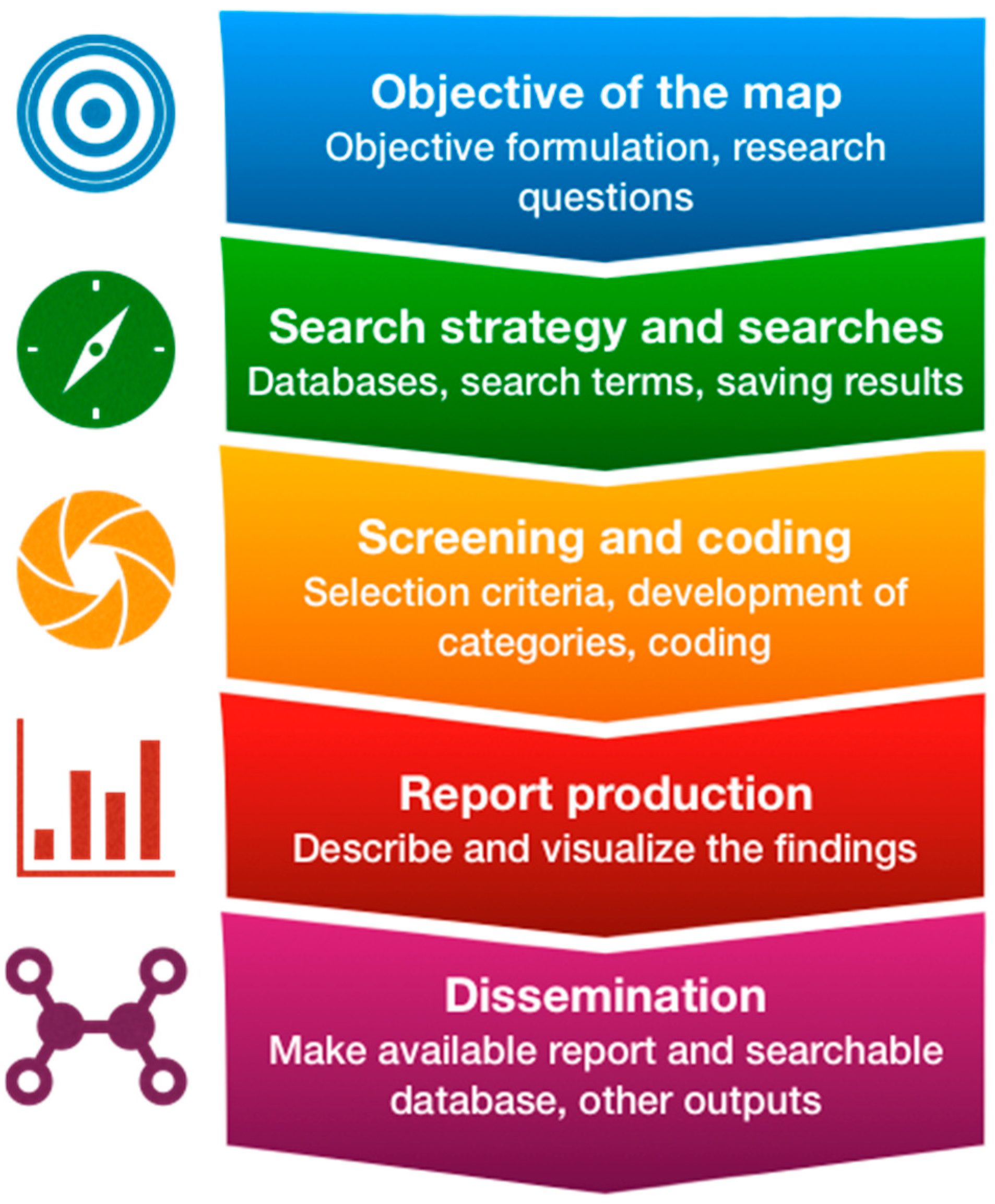

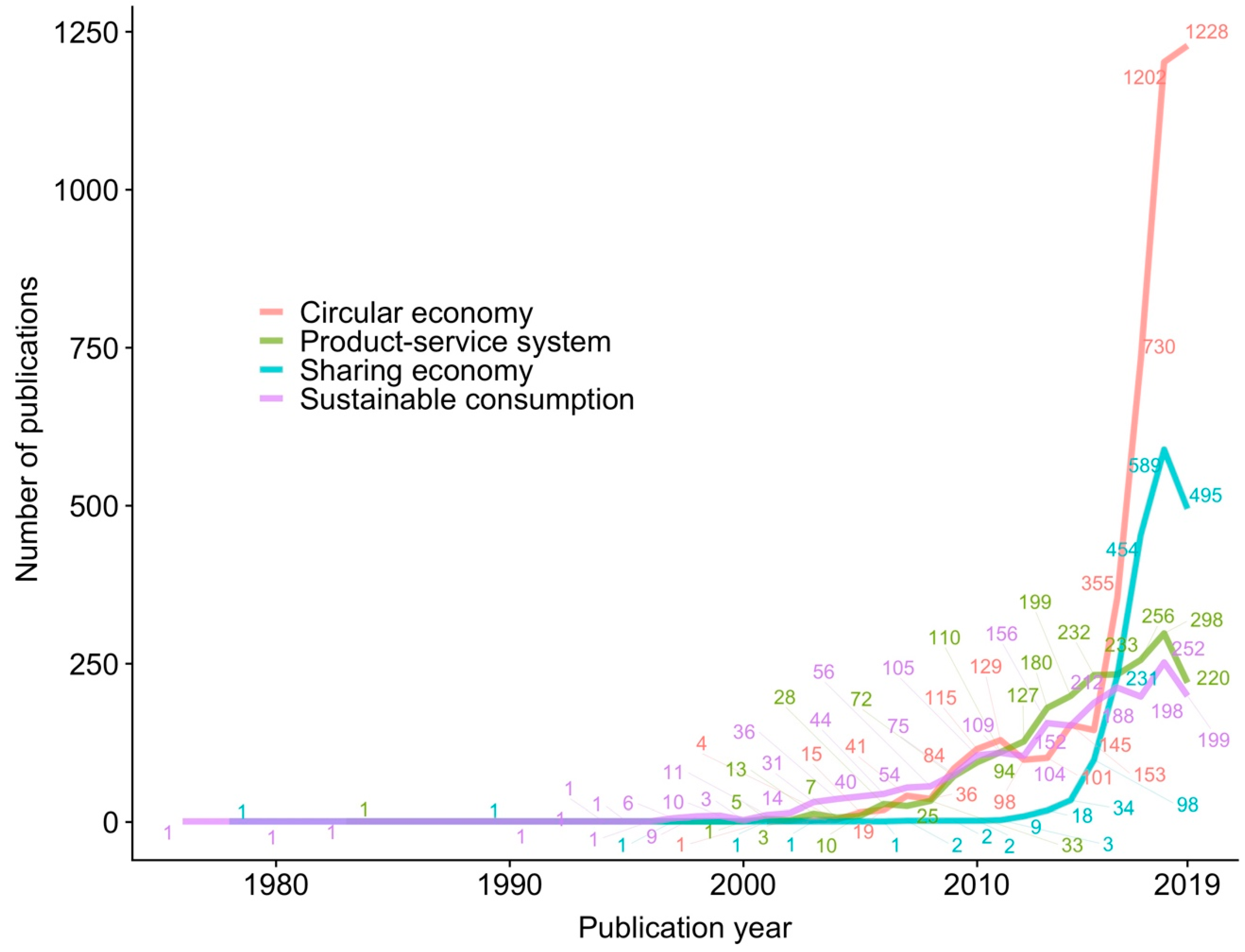
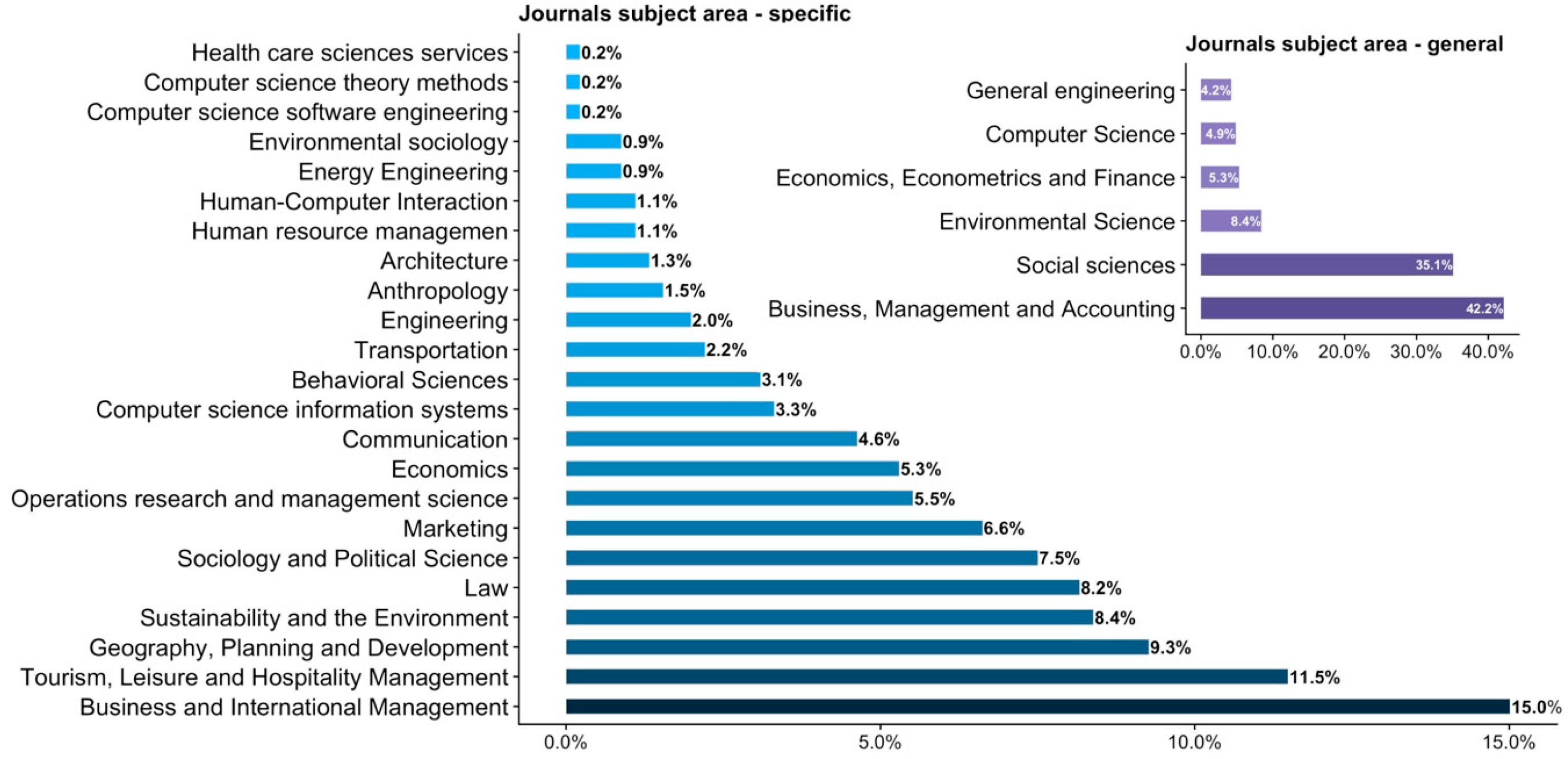
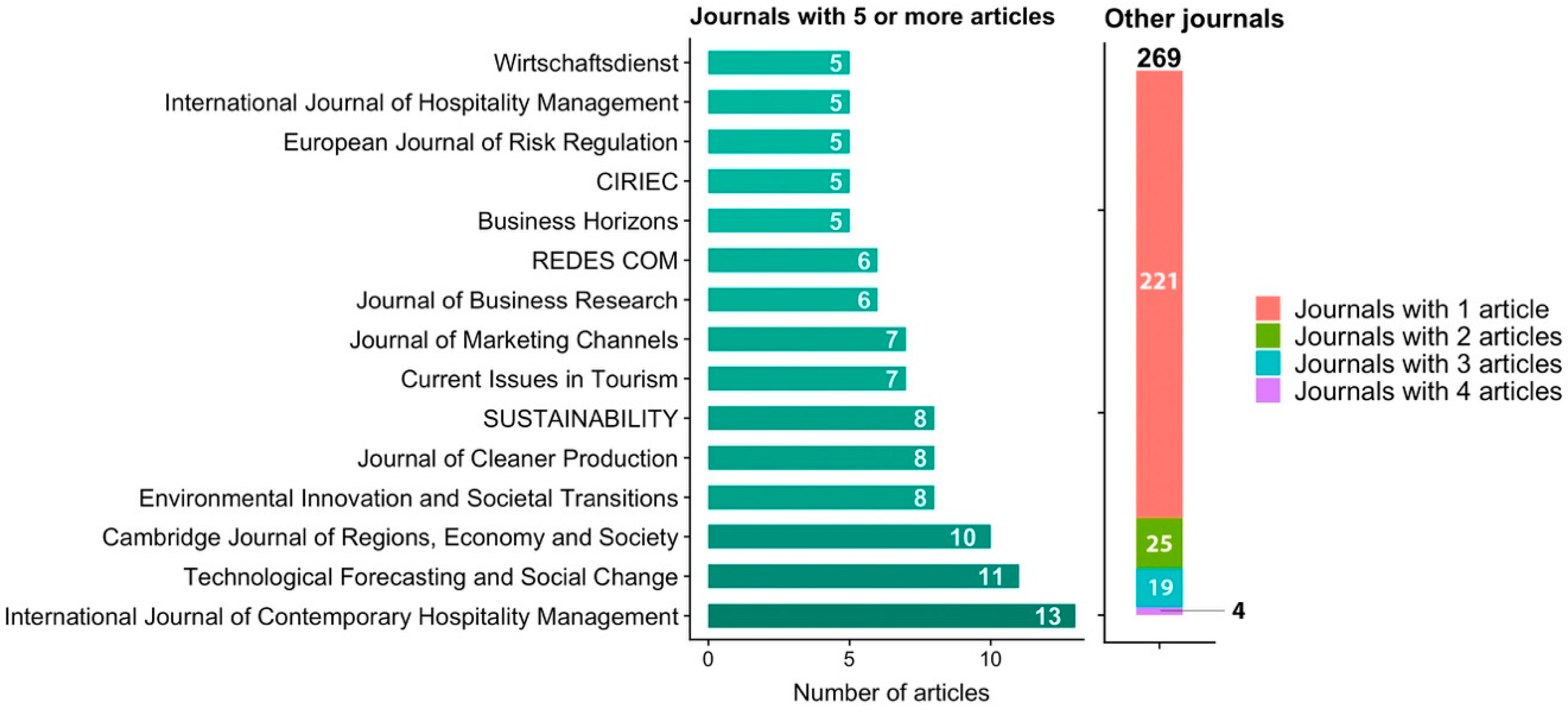
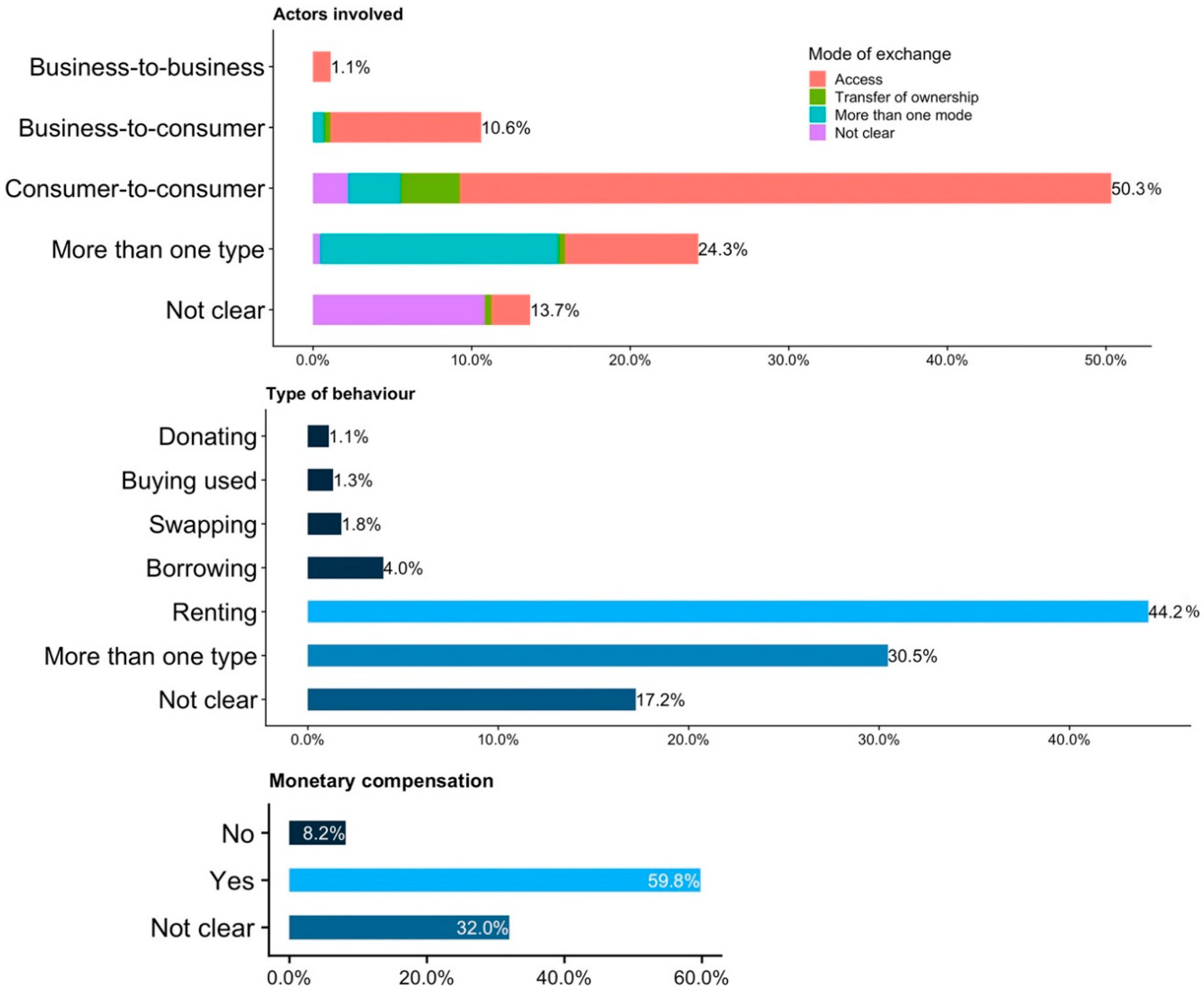
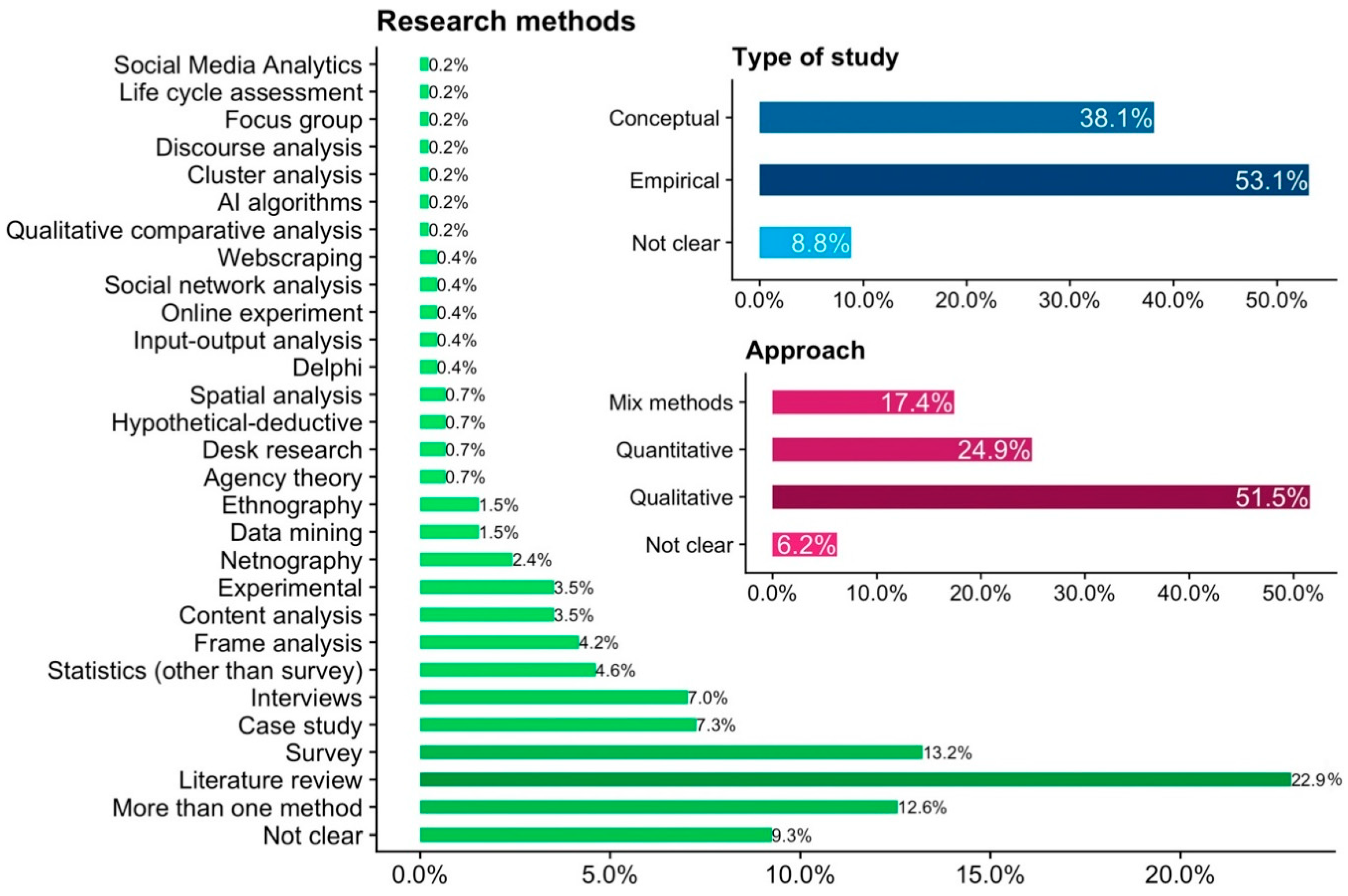
| Search String | Scopus Hits | WoS Hits |
|---|---|---|
| “collaborative economy” | 96 | 72 |
| “collaborative consumption” | 181 | 184 |
| “sharing economy” | 691 | 539 |
| “collaborative production” | 359 | 199 |
| “peer economy” | 20 | 16 |
| “collaborative finance” | 4 | 3 |
| “collaborative education” | 240 | 163 |
| TOTAL | 1591 | 1176 |
| Search String | Scopus Hits | WoS Hits |
|---|---|---|
| “sharing economy” OR “collaborative economy” OR “collaborative consumption” | 837 | 662 |
| Coding Category | Definition | Code Subcategory | References |
|---|---|---|---|
| Sharing sector | Business sector that the article refers to | Several, coded following a grounded approach | [28] |
| Actors involved | Describes the actors involved in the transaction | Consumer-to-consumer Business-to-consumer Business-to-business More than one type Not clear | [29] |
| Type of behavior | Indicates the type of trading activity | Buying used Swapping Borrowing Renting Donating More than one type Not clear | [27] |
| Acquisition mode | Mode of exchange | Transfer of ownership Access over ownership More than one mode Not clear | [27] |
| Compensation scheme | Describes how the sharing transaction is compensated | Monetary Nonmonetary Not clear | [29] |
| Publication area | Knowledge area of the journal that the article was published. It can be seen as the knowledge paradigm under which the publication was written | Several, coded accordingly to Scopus and WoS classification (e.g., social sciences, computer sciences, multidisciplinary) | Scopus and WoS |
| Themes in sharing economy research | Describes the general theme of the publication | Grounded approach of coding and recoding in an iterative way | [30,31] |
| Business Sector | Subsectors |
|---|---|
| Space (21.4%) | shared accommodation (19.8%) coworking office (0.9%) land sharing/farming (0.7%) |
| Mobility (17.6%) | car sharing (17.2%) bike sharing (0.4%) |
| Other intangible assets (3.1%) | crowdwork (2%) time banking (0.7%) energy (0.4%) |
| Food (2.6%) | meal sharing (2.6%) |
| Other tangible assets (2.6%) | clothing (2.2%) books (0.2%) furniture (0.2%) |
| Other sectors (1.3%) | digital manufacturing (0.7%) customs broker (0.2%) journalism (0.2%) healthcare (0.2%) |
| Finance (0.9%) | crowdfunding (0.9%) |
| Not identified 34.8% |
| Research Cluster | Recurring Themes within the Cluster | Cluster Size | Examples of Studies |
|---|---|---|---|
| User behavior | Investigation of preferences and motivation of users and attitude towards sharing; study of human-computer interactions; scrutiny of issues related to reputation, risk and trust and human–computer interaction. | 26.4% | [9,27,34] |
| Business models and organizational aspects | Development and evaluation of new business models for sharing; comparison between traditional and sharing business models; analysis and discussion on emerging challenges to management. | 22.7% | [35,36,37] |
| Institution and governance system | Proposals for implementation of regulation and laws; analysis of matters of ethics and labor; discussion on asymmetric power relationships between actors; argumentation about societal norms. | 18.7% | [38,39,40] |
| Conceptualization matters | Proposal of definitions of the sharing economy, collaborative consumption and collaborative economy; analysis and exploration of the modern sharing discourse; discussion about what sharing economy is and is not; debates about the promises and paradoxes of the paradigm; examination of the societal drivers and barriers to a transition to and scale up a sharing society. | 17% | [3,5,41] |
| Sustainability evaluation | Appraisal, discussion and estimation of: | 15.3% | [42,43,44] |
| social impacts (penetration of the SE in societal areas; impact on the job market and working condition); | Social impacts (8.4%) | ||
| environmental impacts (estimates on possible adverse effects caused by sharing/exchanging business models in the environment); and | Environmental impacts (5.1%) | ||
| economic impacts (measures of business revenue or economic potential). | Economic impacts (1.8%) |
© 2019 by the authors. Licensee MDPI, Basel, Switzerland. This article is an open access article distributed under the terms and conditions of the Creative Commons Attribution (CC BY) license (http://creativecommons.org/licenses/by/4.0/).
Share and Cite
Laurenti, R.; Singh, J.; Cotrim, J.M.; Toni, M.; Sinha, R. Characterizing the Sharing Economy State of the Research: A Systematic Map. Sustainability 2019, 11, 5729. https://doi.org/10.3390/su11205729
Laurenti R, Singh J, Cotrim JM, Toni M, Sinha R. Characterizing the Sharing Economy State of the Research: A Systematic Map. Sustainability. 2019; 11(20):5729. https://doi.org/10.3390/su11205729
Chicago/Turabian StyleLaurenti, Rafael, Jagdeep Singh, Joao Miguel Cotrim, Martina Toni, and Rajib Sinha. 2019. "Characterizing the Sharing Economy State of the Research: A Systematic Map" Sustainability 11, no. 20: 5729. https://doi.org/10.3390/su11205729
APA StyleLaurenti, R., Singh, J., Cotrim, J. M., Toni, M., & Sinha, R. (2019). Characterizing the Sharing Economy State of the Research: A Systematic Map. Sustainability, 11(20), 5729. https://doi.org/10.3390/su11205729







